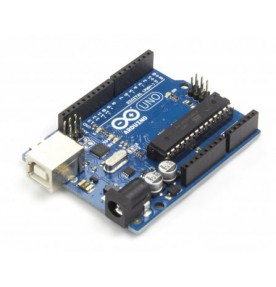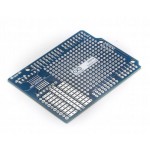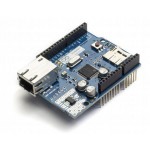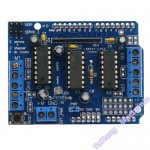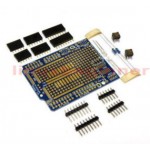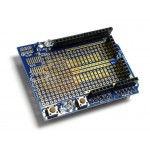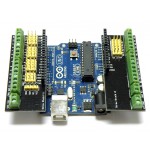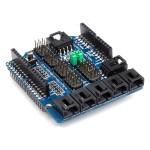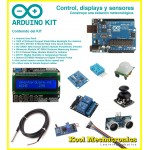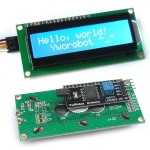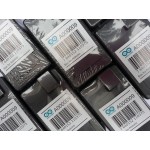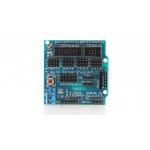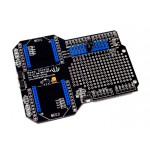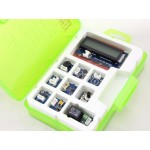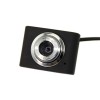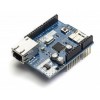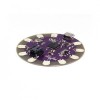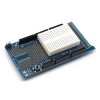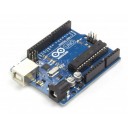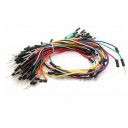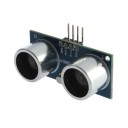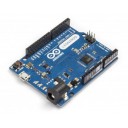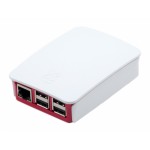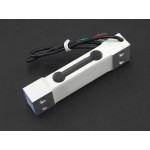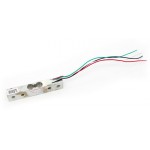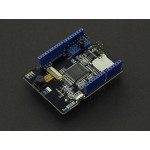The Arduino Uno is a microcontroller board based on the ATmega328 (datasheet). It has 14 digital input/output pins (of which 6 can be used as PWM outputs), 6 analog inputs, a 16 MHz crystal oscillator, a USB connection, a power jack, an ICSP header, and a reset button. It contains everything needed to support the microcontroller; simply connect it to a computer with a USB cable or power it with a AC-to-DC adapter or battery to get started.
The Uno differs from all preceding boards in that it does not use the FTDI USB-to-serial driver chip.
Additional features coming with the R3 version are:
- ATmega16U2 instead 8U2 as USB-to-Serial converter.
- 1.0 pinout: added SDA and SCL pins for TWI communication placed near to the AREF pin and two other new pins placed near to the RESET pin, the IOREF that allow the shields to adapt to the voltage provided from the board and the second one is a not connected pin, that is reserved for future purposes.
- stronger RESET circuit.
"Uno" means "One" in Italian and is named to mark the upcoming release of Arduino 1.0. The Uno and version 1.0 will be the reference versions of Arduino, moving forward. The Uno is the latest in a series of USB Arduino boards, and the reference model for the Arduino platform; for a comparison with previous versions, see the index of Arduino boards.
Technical Specifications
| Microcontroller | ATmega328 |
| Operating Voltage | 5V |
| Supply Voltage (recommended) | 7-12V |
| Maximum supply voltage (not recommended) | 20V |
| Digital I/O Pins | 14 (of which 6 provide PWM output) |
| Analog Input Pins | 6 |
| DC Current per I/O Pin | 40 mA |
| DC Current for 3.3V Pin | 50 mA |
| Flash Memory | 32 KB (ATmega328) of which 0.5 KB used by bootloader |
| SRAM | 2 KB (ATmega328) |
| EEPROM | 1 KB (ATmega328) |
| Clock Speed | 16 MHz |
If you want to give a closer look to this board we advice you to visit the officialArduino UNO page in the Hardware Section.
Related Products
Arduino Proto Shield Rev3 PBC
The Arduino Prototyping Shield makes it easy for you to design custom circuits for your next Arduino..
S/.18.88 S/.33.04 Ex Tax:S/.16.00
Arduino Ethernet Shield Rev3 WITHOUT PoE Module
The Arduino Ethernet Shield allows an Arduino board to connect to the internet. It is base..
S/.141.60 S/.212.40 Ex Tax:S/.120.00
Motor Drive Shield Expansion Board L293D
Motor Drive Shield Expansion Board L293D For Arduino UNO, Duemilanove y Mega2560 L293D is a monol..
S/.47.20 S/.66.08 Ex Tax:S/.40.00
Prototype Wiring Shield (en Kit) for Arduino
Prototype Wiring Shield v.5 (en Kit) for Arduino UNO Duemilanove Seeeduino Este producto se entre..
S/.14.16 S/.30.68 Ex Tax:S/.12.00
Prototype Wiring Shield armado for Arduino
Prototype Wiring Shield v.5 for Arduino UNO Duemilanove Seeeduino Este producto se entrega armado..
S/.37.52 Ex Tax:S/.31.80
Screw Shield Screwshield Expansion Board For Arduino
This Arduino Compatible Screw Shield is a terminal expansion board that can be screwed directly to t..
S/.66.08 Ex Tax:S/.56.00
Sensor Shield V4 Digital Analog Module For Arduino
Sensor Shield V4 Digital Analog Module For Arduino Duemilanove / UNO Each functional module has b..
S/.56.64 Ex Tax:S/.48.00
Kit Control, displays y sensores + Arduino UNO
Este kit incluye Un Arduino UNO R3, Un Display Shield de dos líneas de 16 caracteres con 5 pulsadore..
S/.349.28 Ex Tax:S/.296.00
Arduino TFT LCD Screen
El display Arduino Graphic LCD (GLCD) es una pantalla TFT LCD retroilluminada con headers. Puede rep..
S/.118.00 S/.148.68 Ex Tax:S/.100.00
Character LCD Module Display 1602 16x2 interface I2C
Módulo de visualización LCD de 2 líneas por 16 caracteres más un adaptador para conectarlo medi..
S/.56.64 Ex Tax:S/.48.00
Caja para Arduino
Box for Arduino Code: A000009 El Box per Arduino es una caja expresamente proyectada..
S/.56.64 Ex Tax:S/.48.00
Sensor Shield V5 APC220 Bluetooth Analog Module Servo Motor
Compared with the Arduino Sensor Shield V4 , there are not too many change for V5 base on V4, mainly..
S/.56.64 Ex Tax:S/.48.00
SD Card Shield V4.0
This is the new-released SD card V4.0 shield. It provides a storage space for your Arduino. Users ca..
S/.75.52 Ex Tax:S/.64.00
Bees Shield
Bees shield will make interfacing multiple Bee-style (XBee, GPS Bee, Bluetooth Bee and etc) easier t..
S/.61.36 Ex Tax:S/.52.00
Grove Starter Kit Plus
Grove es una plataforma electrónica modular para el prototipado rápido. Cada módulo tiene una funció..
S/.354.00 Ex Tax:S/.300.00
Ofertas
300K Pixel USB 2.0 Mini Webcam
Plug and play web camera for your Pi. Displays have high resolution, providing true color images for..
S/.42.48 S/.81.66 Impuestos:S/.36.00
Arduino Ethernet Shield Rev3 WITHOUT PoE Module
The Arduino Ethernet Shield allows an Arduino board to connect to the internet. It is base..
S/.141.60 S/.212.40 Impuestos:S/.120.00
Arduino LilyPad USB - ATmega32U4
La placa LilyPad Arduino ha sido desarollada para las aplicaciones wearables y e-textiles (textiles ..
S/.94.40 S/.144.43 Impuestos:S/.80.00
Arduino MEGA Proto Shield V3 + bread board
The Arduino MEGA Prototyping Shield makes it easy for you to design custom circuits f..
S/.23.60 S/.44.84 Impuestos:S/.20.00
Más Vendidos
Arduino Uno Rev3
The Arduino Uno is a microcontroller board based on the ATmega328 (datasheet). It has 14 digital inp..
S/.113.28 Impuesto:S/.96.00
Male to Male Solderless Flexible Breadboard Jumper Cable Wires For Arduino, 65Pc
49 pcs 120mm length 8 pcs 150mm length 4 pcs 200mm length 4 pcs 240mm length total:65pcs(65p..
S/.25.96 Impuesto:S/.22.00
Ultrasonic Module HC-SR04 Distance Measuring Transducer Sensor
The HC-SR04 ultrasonic sensor uses sonar to determine distance to an object like bats or dolphins do..
S/.28.32 Impuesto:S/.24.00
Arduino Leonardo +headers
Arduino Leonardo es una placa de prototipado electrónico que lleva un microprocesador integrado basa..
S/.118.00 Impuesto:S/.100.00
Ultimos Productos
Grove Starter Kit Plus
Grove es una plataforma electrónica modular para el prototipado rápido. Cada módulo tiene una funció..
S/.354.00 Impuestos:S/.300.00
Official Raspberry Pi B+/2 Red & White Case
Finally! The Official Raspberry Pi Foundation's Raspberry Pi Case is now available! Specially m..
S/.70.80 Impuestos:S/.60.00
Weight Sensor (Load Cell) 0-10kg
Applicable to electronic scale, price computering scale, electronic platform scale, digital scale; p..
S/.75.52 Impuestos:S/.64.00
Weight Sensor (Load Cell) 0-500g
Applicable to electronic scale, price computering scale, electronic platform scale, digital scale; p..
S/.111.30 Impuestos:S/.94.32
Camera Shield
Camera Shield is the first shield board that support photograph, it is based on the solution of VC07..
S/.210.04 Impuestos:S/.178.00
DSO Touch
DSO Touch, is a 2 channels digital pocket size oscilloscope. It is only 10mm thick with an aluminum ..
S/.896.80 Impuestos:S/.760.00

